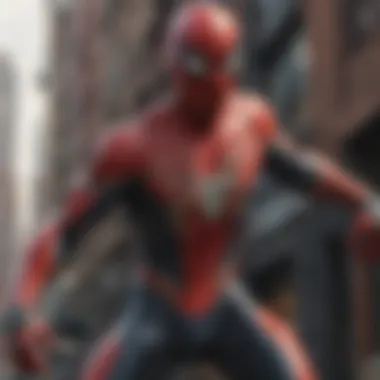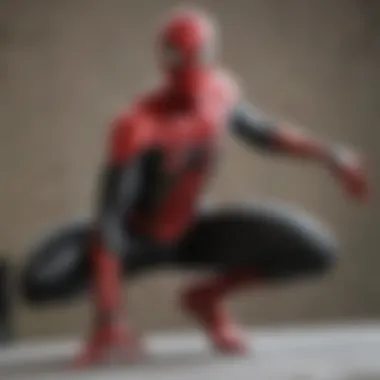Unveiling the Intricacies of Spider-Man: No Way Home Comic Adaptation


Spider-Man Character Analysis
In understanding the intricate world of the Spider-Man: No Way Home comic adaptation, it is essential to first delve into the character analysis of the web-slinging superhero. Spider-Man, originally created by Stan Lee and Steve Ditko, made his first appearance in Amazing Fantasy #15 in 1962. The evolution of Spider-Man from a high school student, Peter Parker, to a seasoned superhero grappling with both personal and heroic responsibilities is a testament to the depth of character development within the Marvel Universe. With powers stemming from a radioactive spider bite, Spider-Man possesses superhuman strength, agility, and the iconic ability to cling to walls, complemented by his intellect and quick wit. The character's growth and key moments, such as the loss of Uncle Ben and pivotal encounters with arch-nemeses like Green Goblin, offer a multifaceted view of moral dilemmas and self-discovery.
Latest Spider-Man News Update
As Spider-Man continues to weave his web across various forms of media, staying abreast of the latest developments is crucial for fans eager to immerse themselves in the Spider-Verse. In the realm of comic books, recent releases have explored new story arcs and crossovers, showcasing Spider-Man's enduring popularity and narrative versatility. The silver screen also beckons with upcoming movie releases promising fresh adventures for Peter Parker, alongside casting updates and tantalizing trailers hinting at spectacular visual feats. In the gaming sphere, the web-slinger swings into action with exciting video game releases, downloadable content expansions, and gameplay enhancements that transport players into the heart of New York City alongside their favorite hero.
Top Villains in Spider-Man Universe
No hero is complete without a rogues' gallery of formidable foes, and Spider-Man's is as diverse as it is diabolical. From the maniacal Green Goblin to the tentacled Doctor Octopus and the symbiote-infused Venom, the web-head has faced a myriad of challenges that test his resolve and morality. Understanding the origins and motivations of these iconic villains provides insight into the darker aspects of the Spider-Man mythos, revealing the interconnected web of conflicts that define the superhero's journey. Memorable battles that pit Spider-Man against his greatest adversaries showcase not only his physical prowess but also the strength of his character in facing insurmountable odds and personal demons.
Spider-Man Movie Reviews
As the web-slinger swings from comic panels to the silver screen, movie reviews serve as a compass for fans navigating the vast landscape of cinematic adaptations. Providing a plot summary of the latest Spider-Man movies offers a glimpse into the narrative arcs, twists, and character developments that captivate audiences and provoke thought. Character portrayals by lead actors breathe life into Peter Parker and his supporting cast, shaping the emotional core of the movies and leaving a lasting impact on viewers. Evaluating the visual effects and action sequences not only highlights the technical prowess of filmmakers but also underscores the dynamic nature of Spider-Man's adventures, where every swing, punch, and quip adds layers of depth to the storytelling.
Introduction
As we embark on this journey through the Spider-Man: No Way Home comic adaptation, we are delving into a realm of storytelling that intertwines intricacy and fascination. This article serves as a guide, shedding light on the nuances of the comic's narrative, characters, and pivotal moments. By delving into the origins of this adaptation and its significant role within the Spider-Verse, readers will develop a profound understanding of its place in the expansive Marvel universe.
Brief Overview of Spider-Man: No Way Home Comic
Introduction of Multiverse Concept
The introduction of the multiverse concept in the Spider-Man: No Way Home comic adaptation is a pivotal element that sets the stage for a mind-bending exploration of parallel dimensions. This concept of multiple realities existing simultaneously allows for a rich tapestry of storytelling possibilities, offering unexpected twists and encounters for our beloved characters. The uniqueness of the multiverse concept lies in its ability to transcend traditional narrative boundaries, opening doors to uncharted creative avenues while posing intellectual challenges to both creators and audiences alike.
Key Characters Featured
Within the Spider-Man: No Way Home comic adaptation, the array of key characters featured adds layers of depth and complexity to the overarching narrative. From familiar faces to new allies and adversaries, each character brings a distinct essence to the storyline, shaping the dynamics of the Spider-Verse in unparalleled ways. By examining the roles and development of these characters, readers can appreciate the intricate web of relationships and conflicts that drive the plot forward, making every interaction a crucial piece in the larger puzzle of the comic adaptation.
Main Plotline Synopsis
The main plotline of Spider-Man: No Way Home comic adaptation weaves a tale of intricate twists and turns, immersing readers in a gripping saga of heroism and sacrifice. At the core of this narrative lies a web of interconnected events that challenge the very fabric of reality, pushing our protagonists to confront their deepest fears and desires. From unexpected alliances to heart-wrenching betrayals, each plot development propels the story forward, culminating in a climactic showdown that will test the resilience of our beloved characters.
Comparison with Movie Adaptation


Divergence in Plot Elements
[Your detailed content here]
Character Portrayals
[Your detailed content here]
Fan Reactions
[Your detailed content here]
Spider-Man: No Way Home Comic Insights
In this section, we will delve deep into the intricate world of the Spider-Man: No Way Home comic adaptation. By exploring the key story arcs and artistic representation, we aim to provide a comprehensive guide for Spider-Man enthusiasts of all ages. This analysis will shed light on the evolution of Peter Parker, the introduction of villains from alternate realities, and the impact of this comic on the broader Spider-Man lore.
Key Story Arcs Explored
Introducing Villains from Alternate Realities
The incorporation of villains from alternate realities in the Spider-Man: No Way Home comic adaptation is a bold and intriguing choice. This approach adds a layer of depth and complexity to the narrative by introducing antagonists that challenge the traditional boundaries of the Spider-Man universe. The unique feature of bringing in villains from different dimensions provides endless opportunities for creative storytelling and character development. While this decision may seem risky, its contribution to the overall storyline enriches the reader's experience and sets this comic adaptation apart from conventional superhero narratives.
Collaborations with Other Marvel Characters
Spider-Man's collaborations with other Marvel characters elevate the comic adaptation to new heights. The synergy between different superheroes amplifies the excitement and possibilities within the narrative, offering fans a glimpse into a larger, interconnected universe. By showcasing these collaborations, the comic not only expands the Spider-Man lore but also opens doors to explore diverse character dynamics and storylines. This strategic move enhances the richness of the comic adaptation and caters to a wider audience, catering to both Spider-Man aficionados and Marvel enthusiasts.
Evolution of Peter Parker
The evolution of Peter Parker within the Spider-Man: No Way Home comic adaptation is a crucial aspect that drives the plot forward. By focusing on Peter's character development, readers witness a dynamic and multi-dimensional portrayal of the iconic web-slinger. This exploration of Peter's journey adds depth to the overall narrative, allowing for themes of growth, resilience, and self-discovery to take center stage. Through Peter's evolution, the comic adaptation not only showcases the protagonist's inner struggles but also underscores the essence of heroism and sacrifice in the face of adversity.
Artistic Style and Visual Representation
Illustrative Techniques Used
The illustrative techniques employed in the Spider-Man: No Way Home comic adaptation are a visual treat for readers. From dynamic panel layouts to vibrant color schemes, the artwork captivates audiences and brings the narrative to life. The meticulous attention to detail in each illustration enhances the storytelling, allowing for seamless transitions between action sequences and introspective moments. By utilizing innovative techniques, such as foreshortening and perspective, the comic achieves a heightened sense of realism and immersion, drawing readers into Spider-Man's world with each turn of the page.


Character Design Innovations
The character design innovations in the Spider-Man: No Way Home comic adaptation showcase a fresh approach to iconic Marvel figures. Characters are reimagined with intricate details and distinctive features that not only pay homage to their traditional designs but also inject a modern flair into their appearance. The use of expressive facial expressions and dynamic poses conveys depth and emotion, bringing a sense of authenticity to each character's personality. Through these innovations, the comic adaptation manages to strike a balance between honoring the legacy of these beloved characters and infusing new energy into their visual presentation.
Impact on Spider-Man Lore
Canonization of Multiverse
The canonization of the multiverse concept in the Spider-Man: No Way Home comic adaptation reshapes the Spider-Man lore in profound ways. By establishing the existence of multiple realities and interconnected dimensions, the comic opens up endless storytelling possibilities and narrative avenues. This narrative choice not only expands the scope of Spider-Man's universe but also cements the significance of alternate realities in shaping the character's destiny. The integration of the multiverse concept underscores the vastness and intricacy of Spider-Man's world, inviting readers to explore the limitless permutations of his iconic adventures.
Influence on Subsequent Comic Storylines
The influence of the Spider-Man: No Way Home comic adaptation on subsequent storylines is undeniable. By setting new precedents and narrative directions, this comic leaves a lasting impact on the fabric of Spider-Man's mythos. The themes, characters, and concepts introduced in this adaptation serve as a foundation for future comic arcs, inspiring creativity and innovation within the Marvel Universe. This influential ripple effect resonates across various comic series, enriching the overall continuity and contributing to the dynamic evolution of Spider-Man's narrative landscape.
Character Analysis and Development
Spider-Man: No Way Home comic adaptation offers a profound exploration of character development, a pivotal aspect in understanding the intricate world of superheroes. Analyzing characters like Peter Parker and Miles Morales allows readers to delve deep into their psyche, motivations, and growth throughout the storyline. By dissecting their actions, reactions, and decisions, we unravel the complexity of these protagonists, showcasing the evolution of their personas within the Spider-Verse. Character Analysis and Development in this article plays a crucial role in illuminating the intricacies of these beloved heroes, providing a nuanced perspective on their transformations and significance within the narrative.
Exploring the Protagonists
Peter Parker's Journey
Delving into Peter Parker's Journey unveils a rich tapestry of personal struggles, moral dilemmas, and heroic endeavors. His evolution from a humble teenager to a seasoned crime-fighter showcases resilience, wit, and the burden of responsibility. Peter's internal conflicts, relationships with allies and enemies, and his unwavering sense of justice define his journey. The juxtaposition of vulnerability and strength in Peter's character makes him a relatable, multi-dimensional hero resonating with the audience's core emotions. This exploration of Peter Parker's Journey offers profound insights into heroism, sacrifice, and the enduring spirit of Spider-Man within the comic adaptation.
Miles Morales' Role
Miles Morales' Role brings a refreshing perspective to the Spider-Man universe, illuminating diversity, representation, and a unique sense of identity. His background, interplay with Peter Parker, and emergence as a hero in his own right enrich the narrative tapestry of No Way Home comic adaptation. Miles' youthful energy, cultural nuances, and modern sensibilities add a dynamic layer to the storyline, complementing Peter's seasoned experience with fresh insights and growth opportunities. By exploring Miles Morales' Role, readers embark on a journey of discovery, empathy, and empowerment, appreciating the relevance of varied voices and aspirations in shaping the superhero legacy.
Antagonists and Their Motivations
Understanding Villains' Backstories
Diving into Understanding Villains' Backstories unravels the intricacies of these antagonists' motives, traumas, and ambitions. By peeling back the layers of their past, fears, and desires, we gain a deeper understanding of the challenges they pose to our protagonists. The humanization of villains through their backstories adds depth and complexity to their characters, blurring the lines between hero and villain, right and wrong. This exploration enriches the narrative landscape, injecting empathy, conflict, and moral ambiguity into the overarching tale of heroism and struggle within the Spider-Verse.
Conflict Dynamics


Exploring Conflict Dynamics highlights the interplay of opposing forces, ideologies, and goals within the No Way Home comic adaptation. The tensions, clashes, and resolutions between heroes and villains drive the narrative forward, infusing every encounter with suspense, emotion, and thematic richness. The intricate web of conflicts, internal and external struggles, and ethical dilemmas faced by characters amplifies the narrative stakes, keeping readers engrossed in the myriad shades of gray that define heroism and villainy. By examining Conflict Dynamics, readers navigate the intricate relational dynamics, power struggles, and consequences that shape the evolving landscape of Spider-Man's universe.
Fan Reception and Legacy
Fan reception and legacy play crucial roles in evaluating the impact and significance of the Spider-Man: No Way Home comic adaptation. The way fans receive and perceive this adaptation can shape its lasting influence on the Spider-Man universe and beyond. Understanding the nuances of fan reactions and the legacy it leaves behind provides valuable insights into the adaptation's cultural relevance and longevity. Fans, being the heart and soul of any comic adaptation, can fuel its success and establish its place in the comic canon.
Critical Acclaim and Controversies
Positive Reviews
Positive reviews are pivotal in shaping the public perception and success of any creative work, including the Spider-Man: No Way Home comic adaptation. These reviews not only highlight the strengths and merits of the adaptation but also serve as a gauge of its impact on the audience. Positive reviews can draw new readers into the Spider-Man universe, creating a buzz around the adaptation and boosting its popularity among existing fans. The distinctive features praised in positive reviews provide valuable insight into what captivates readers and keeps them engaged with the storyline and characters.
Controversial Plot Elements
Controversial plot elements add depth and intrigue to the Spider-Man: No Way Home comic adaptation, sparking debates and discussions among fans and critics alike. These elements challenge traditional narratives and offer unique perspectives on familiar characters and story arcs. While controversial aspects may polarize audiences, they also have the potential to stir emotions, provoke thoughts, and ultimately enrich the overall reading experience. Embracing controversial plot elements demonstrates a willingness to push boundaries and explore new storytelling avenues, keeping the adaptation both relevant and thought-provoking.
Award Nominations
Receiving award nominations is a testament to the creative excellence and impact of the Spider-Man: No Way Home comic adaptation. Such nominations not only validate the hard work and talent of the comic creators but also elevate the adaptation's status within the industry. Recognition through award nominations can attract new audiences, establish credibility, and inspire future adaptations to strive for similar levels of innovation and storytelling excellence. The unique features acknowledged in award nominations showcase the adaptation's ability to resonate with readers on a profound and lasting level.
Influence on Subsequent Spider-Man Adaptations
Multiverse in Cinematic Universe
The incorporation of the multiverse concept into the cinematic universe is a groundbreaking development influenced by the Spider-Man: No Way Home comic adaptation. This concept opens up infinite storytelling possibilities, allowing for the exploration of alternate realities, characters, and plotlines. By introducing the multiverse, subsequent Spider-Man adaptations can delve into complex narratives, enrich character dynamics, and surprise audiences with unexpected twists and connections. Embracing the multiverse enriches the Spider-Verse lore and paves the way for a more diverse and engaging comic adaptation landscape.
Cross-Pollination of Characters
The cross-pollination of characters across different Spider-Man adaptations is a testament to the interconnected nature and continuity established by the Spider-Man: No Way Home comic adaptation. By weaving together various characters from distinct storylines and universes, adaptations can create a cohesive and immersive narrative experience for readers. This cross-pollination fosters new collaborations, alliances, and conflicts that challenge characters to grow and evolve in exciting ways. The unique feature of cross-pollination enhances the richness and depth of the Spider-Verse, providing fans with a more comprehensive and interconnected comic adaptation experience.
Conclusion
In wrapping up the extensive exploration of the Spider-Man: No Way Home comic adaptation, it becomes apparent that this adaptation holds a paramount significance in the Marvel Universe. The intricate storyline, multifaceted characters, and captivating visuals all contribute to its enduring legacy. As readers traverse through the narrative intricacies of this comic, they gain profound insights into the depths of the Spider-Verse and the dynamic evolution of its characters.
Significance of Spider-Man: No Way Home Comic
Legacy in Comic Canon
The aspect of 'Legacy in Comic Canon' within Spider-Man: No Way Home transcends mere storytelling; it embodies a pivotal moment in the Spider-Man saga. This facet not only pays homage to the character's rich history but also propels it into new realms of creativity and innovative storytelling. The legacy of this adaptation lies in its ability to resonate with readers across generations, solidifying its position as a cornerstone in the ever-expanding comic universe.
Interconnected Spider-Verse
Delving into the 'Interconnected Spider-Verse' reveals a web of interconnected narratives that transcend individual storylines. This aspect not only broadens the scope of the Spider-Man universe but also intricately weaves together various characters, timelines, and dimensions. The interconnectedness of the Spider-Verse adds layers of depth and complexity, inviting readers to explore the vast expanse of possibilities that exist within this intricate web of parallel worlds.







